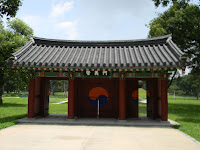Following the early morning departure from Daegu, we traveled about 1-1/2 hours to Haein-sa Temple. This Buddhist temple complex, nestled in the safety of Gayasan Mountain, is isolated enough to continue providing a legitimately meditative oasis and yet is close enough to Daegu and other accommodations so as to be convenient for visitors.
In the main courtyard, you will find a maze marked out on the ground (currently lined with lanterns to which written prayers can be attached). This maze coincides with a Buddhist poem that discusses the twists and turns that we experience in our quest to find "the way". Many in our group chose to walk the path of the maze, which should be accomplished in silence so as to allow your mind to focus on freeing itself of the distractions of life and focus simply on "the way."
Additionally, in the courtyard you will find the traditional temple platform which supports the bell, the drum, and other instruments used in summonsing all "sentient beings" to prayer. We were able to witness the summons which began with three monks taking turns on the drum; it was very intriguing the way that they would shift to the side as their turn was ending which would then allow another to slip in and to begin his turn without interrupting the sound.
As the monks made the transition from the drum to the bell a song which my church's choir sings began flowing through my mind: "Holy Spirit rain down..." All of a sudden this wonderful gentle rain began falling. It was so peaceful and just that extra "something special" to add to the moment.
As the sounds for the call to prayer, the three monks scurried off to join their brothers (and maybe sisters too, since female monks are allowed) who were already chanting their prayers prior to lunch. Our group respectfully followed behind so as to quietly enter the temple so as to observe some of the art on the walls. It is considered disrespectful to take pictures while actually inside the temple so I do not have images of the paintings depicting the traditional eight moments in the life of the Buddha. From outside of the temple, I was able to "zoom in" so as to get a couple of images of the Buddha statues.
Following our venture into the temple itself it was time for lunch. Arrangements had been made for us to dine in the cafeteria of the temple complex. There were to caveats for dining: 1) you must eat in total silence...no talking and 2) you may take as much as you like from the serving line to eat but you must finish every single morsel of food so as not to be wasteful. The selection include noodles, rice, cucumbers, spinach, a vegetarian sauce, watermelon, and tea. Even with chopsticks (and my soup spoon) I was able to fulfill the requirements for dining.
After lunch we hiked to the highest point in the temple complex to see the buildings which house Haein-sa's greatest treasure: the Tripitaka Koreana. The Tripitaka is the total sum of Buddhist scriptures carved onto 81,000+ wood blocks. From these wood blocks the scriptures can then be printed onto paper. The current Tripitaka collection is actually the second set of the scriptures made on wood blocks in Korea. The first was destroyed during the Mongol invasion and a second set was completed in 1252. Currently, visitors are not allowed to enter the specially designed buildings with serve as the library for the Tripitaka.
 |
| from a photo display nearby the library hall |
Following another rain shower, we concluded our time at Haein-sa and began the four hour drive back to Seoul.































































